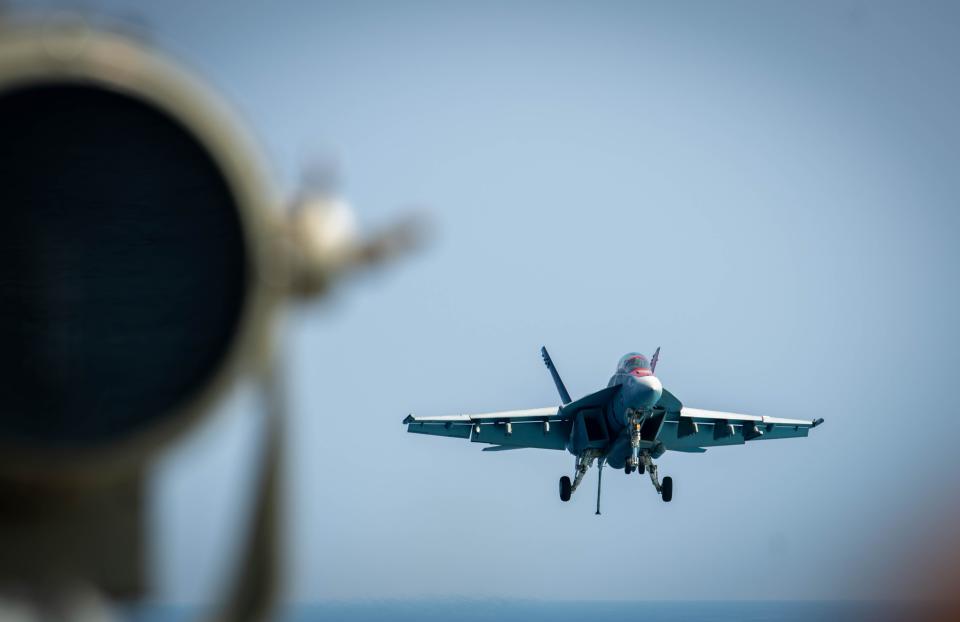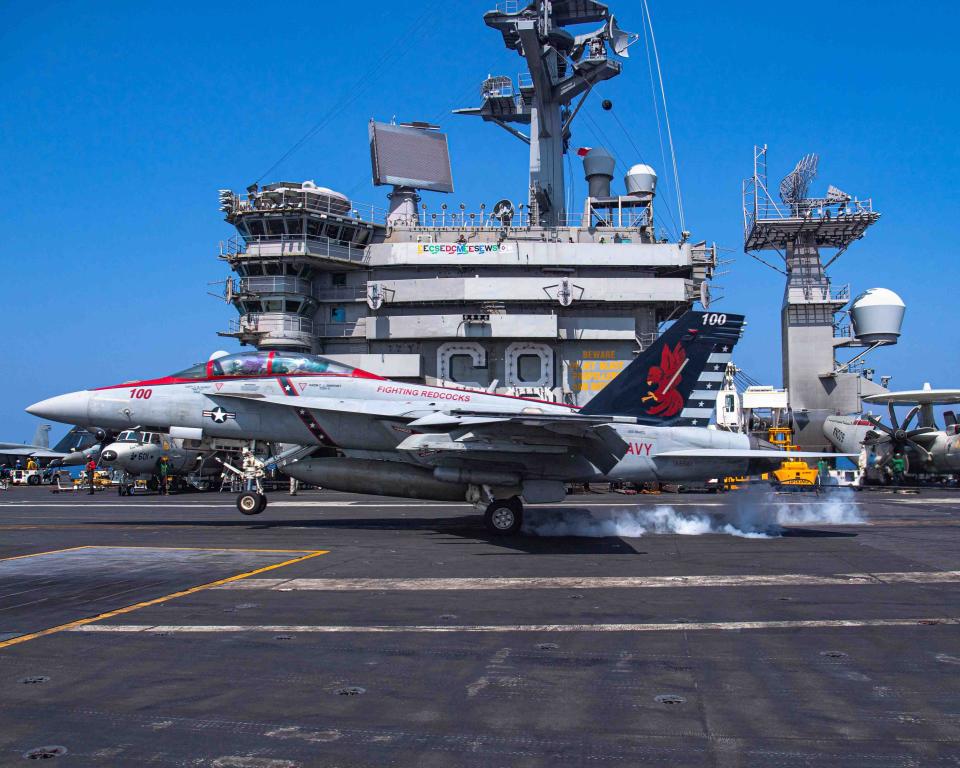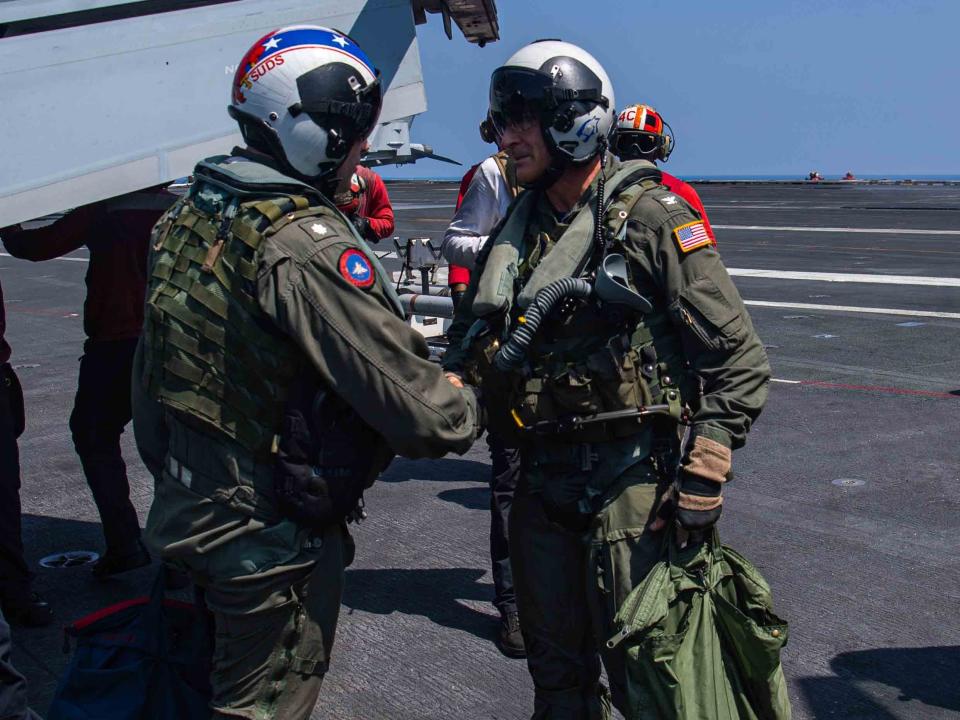A Navy jet just landed on the aircraft carrier USS Nimitz for the 350,000th time, but the famous flattop's days are numbered
A fighter jet landed on the USS Nimitz for the 350,000th time — a historic milestone.
The aircraft carrier became the first in active service to hit that mark after 48 years in the Navy.
But the flattop's days are numbered, and it's slated to be scrapped within the next few years.
A fighter jet recently landed aboard the US Navy's oldest-serving aircraft carrier for the 350,000th time, marking a historic achievement for USS Nimitz before the ship's decades of service come to an end.
An F/A-18F Super Hornet from the Strike Fighter Squadron 22 made an arrested landing on the 48-year-old Nimitz on the morning of April 22 as the vessel transited waters in the South China Sea. The jet, a cornerstone of American naval aviation, was piloted by Capt. Craig Sicola, commanding officer of the Nimitz, and Cmdr. Luke Edwards, commanding officer of the squadron.
It marked the 350,000th time that a fixed-wing aircraft has landed on the flight deck of the carrier. It's the first time an aircraft carrier in active service has reached this milestone. Aircraft carrier USS Dwight D. Eisenhower has recorded 326,600 arrested landings, the next highest total.
"I am honored and humbled to land this historic milestone for our ship," Sicola said in a Navy statement. "I dedicate this landing to the countless naval aviators who have flown before me, and it is a privilege to further the proud tradition of service that this distinguished aircraft carrier embodies."
"To the shipyard maintenance teams who put in countless hours to prepare this warship for sea, to the thousands of dedicated Sailors on board who sacrifice for their country, and to the families back home who support us along the way — 'teamwork is a tradition' on Nimitz and we could not have accomplished this mission without the steadfast commitment to this historic ship," he added.
Photographs published by the Navy show the Super Hornet landing on the Nimitz's flight deck, as well as the embrace by the two pilots afterwards. But the Navy said in its statement that a proper celebration had to wait because there were more aircraft that needed to land. So sailors reset the arresting cable and moved the aircraft out of the landing area.
"Mighty Nimitz had to get ready for trap number 350,001," the Navy said.



Building on the lessons of USS Enterprise, the only nuclear-powered aircraft carrier before it, the Nimitz was commissioned in May 1975 and was the first of 10 such vessels in a new class of nuclear-powered supercarriers that has served the US Navy for decades.
The 1,092-foot-long USS Nimitz named after the legendary World War II naval commander Adm. Chester William Nimitz Sr. was one of the largest ships on earth at the time of its commission and saw participation in multiple major military operations involving deployments all over the world.
For instance, the Nimitz has supported operations in Iraq, as well as missions in Afghanistan, and it also played a role in a historic show of force during the Third Taiwan Strait Crisis that, for a time, curbed China's efforts to intimidate Taiwan.
Its time in service, which spans nearly half a century, is drawing to a close though.
Last month, the Navy published a notice that detailed the beginning of plans to scrap the Nimitz. The vessel will be only the second American nuclear-powered carrier after the Enterprise slated to be scrapped. The process is expected to be slow and technically challenging given the logistical and safety precautions involved in the process.
The Nimitz was originally expected to leave service in 2025, but it has received a 13-month life extension and will depart the Navy in 2026, USNI News reported. After its last deployment, the ship will head to Huntington Ingalls' Newport News Shipbuilding to start the process of deactivation.
Though Nimitz-class ships remain a prominent presence in the US Navy, the future of the Navy carrier fleet is the new Ford-class aircraft carriers, the first of which just recently set sail on its first full deployment. These new carriers feature a suite of new technologies aimed at giving these new ships an edge over their Nimitz-class predecessors.
Read the original article on Business Insider

 Yahoo News
Yahoo News 
